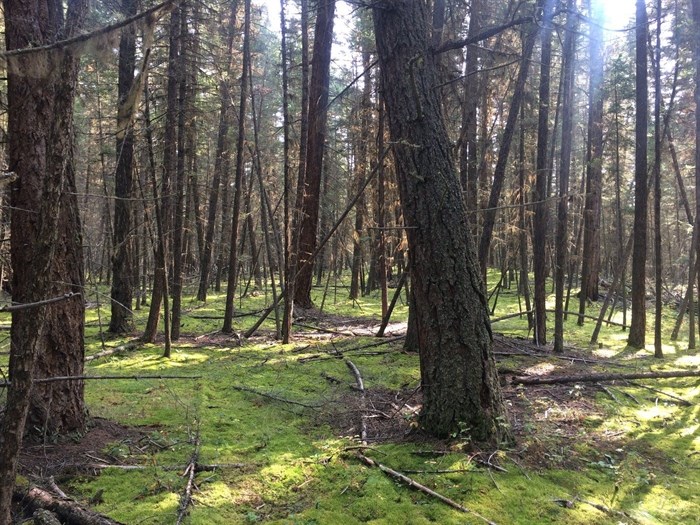
A new report reveals that preserving British Columbia's interior old-growth forests could generate billions in economic value, offering far greater economic return than timber. An old-growth Interior Douglas-fir forest.
Image Credit: Government of B.C.
April 15, 2025 - 7:00 PM
Protecting old-growth forests in the BC interior could generate more than $43 billion over the next century — far more than logging the land, a report says.
Research by environmental consultancy ESSA Technologies determined that if all the old-growth forest in regions around the Okanagan and Prince George were fully protected, the carbon storage alone would keep 28 million tonnes of carbon emissions out of the atmosphere over the next 100 years. That’s roughly what would be generated by burning 63 million barrels of oil, and would be worth $43 billion — $33 billion for Prince George and $10 billion for the Okanagan. Even limited protection of only the most at-risk forests would yield $11 billion in benefits.
“The value of the forests of British Columbia are much, much, much broader and bigger than just timber, which we have, traditionally, always and only looked at," said Rachel Holt, an ecologist who specializes in forest management policy in B.C.
The report looked at two timber supply areas in the Okanagan, which include the territories of the Sylix, Secwepemc, and Nlaka'pamux Nations, and the Prince George region, which are mostly of the Carrier Sekani’s traditional territories.
Expanding BC interior forest management to include values beyond timber was long overdue as the region’s green expanses threaten to disappear, said Garry Merkel, a Tahltan forester from the Stikine River in northwest BC and director of the Centre for Indigenous Land Stewardship in the Faculty of Forestry at the University of British Columbia.
“The clear-cuts are huge... if you stand in some of those valleys, you can’t even see the end of them. They've basically cleared the whole interior,” Merkel said.
In 2022, the total annual economic contribution of BC’s entire forestry sector, including logging, to the province’s GDP was $17.4 billion. Over the years, policy changes to prioritize conservation and the decline of post-mountain pine beetle salvage logging have reduced allowable annual cuts in the Okanagan and Prince George timber supply areas.
Jens Wieting, senior policy and science advisor with Sierra Club BC, which co-funded the new report, said the Great Bear Rainforest Agreement provided a model for solutions focused on protecting forests, funding for conservation efforts and support for a conservation economy.
According to Wieting, the report is conservative. It undervalues the huge potential of conservation and excludes broader benefits such as flood protection, drought mitigation and reduced risk of landslides — all of which are influenced by the health of forests and would likely add to the estimated value.
The report found ecotourism and recreation, driven by people seeking scenic hikes, photography and wellness retreats among towering trees, would inject $791 million into local economies. Non-timber forest products such as wild mushrooms, floral greenery, medicinal plants, essential oils and materials for artisans would provide recurring income streams in these regions.
“How do we as a society continue to get the most out of our forests from an economic perspective, and translate a lot of these services into actual real dollars?” Merkel said.
Many Indigenous communities across these areas have long advocated for stronger protections for old-growth forests, many of which are under economic pressure to accept logging revenue.
“This report is an important step in recognizing the true value of our lands and resources,” said Grand Chief Stewart Phillip, president of the Union of BC Indian Chiefs, in a release. “It affirms what First Nations have always known — that sustainable stewardship and Indigenous knowledge are key to long-term prosperity.”
Merkel co-chaired the old-growth review panel for the BC government that developed the Old Growth Strategic Review. Based on its recommendations, the province committed to stop logging in high-risk forests and move to a more sustainable value-based economy. But since then, over 31,800 hectares of land identified for protection have been logged.
Holt, who was involved in early stages of the report, said the added pressure of US tariffs gives the government even more incentive to shift toward a community-based, local industry that focuses on producing regional products.
“As a friend of mine recently said, there is no economy without the eco,” said Holt. “We have to put stewardship first and build a completely different, resilient industry.”
The question now isn’t whether to act, it’s whether the province will move fast enough to preserve what’s left before it’s gone, said Wieting.
“We have waited a long time with these promises of a paradigm shift,” said Wieting. “We have to stop the bleeding and speed up solutions to protect at-risk old-growth forests.”
— This article was originally published by Canada's National Observer
News from © iNFOnews, 2025